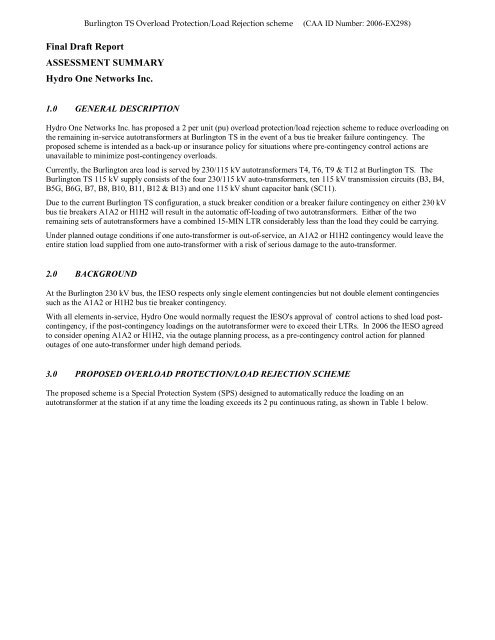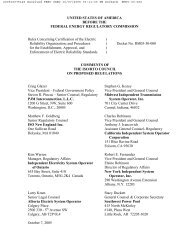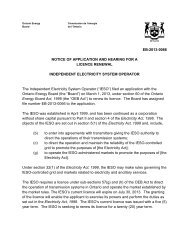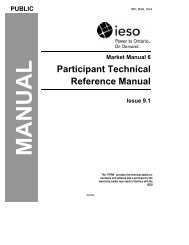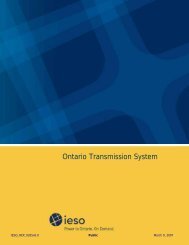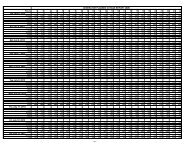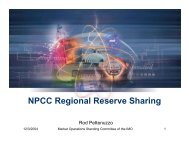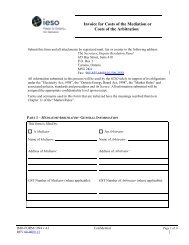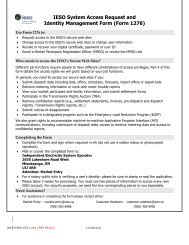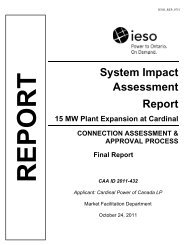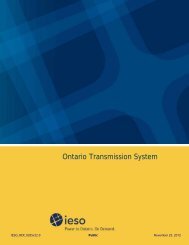Final Draft Report ASSESSMENT SUMMARY Hydro One Networks ...
Final Draft Report ASSESSMENT SUMMARY Hydro One Networks ...
Final Draft Report ASSESSMENT SUMMARY Hydro One Networks ...
You also want an ePaper? Increase the reach of your titles
YUMPU automatically turns print PDFs into web optimized ePapers that Google loves.
Burlington TS Overload Protection/Load Rejection scheme(CAA ID Number: 2006-EX298)<strong>Final</strong> <strong>Draft</strong> <strong>Report</strong><strong>ASSESSMENT</strong> <strong>SUMMARY</strong><strong>Hydro</strong> <strong>One</strong> <strong>Networks</strong> Inc.1.0 GENERAL DESCRIPTION<strong>Hydro</strong> <strong>One</strong> <strong>Networks</strong> Inc. has proposed a 2 per unit (pu) overload protection/load rejection scheme to reduce overloading onthe remaining in-service autotransformers at Burlington TS in the event of a bus tie breaker failure contingency. Theproposed scheme is intended as a back-up or insurance policy for situations where pre-contingency control actions areunavailable to minimize post-contingency overloads.Currently, the Burlington area load is served by 230/115 kV autotransformers T4, T6, T9 & T12 at Burlington TS. TheBurlington TS 115 kV supply consists of the four 230/115 kV auto-transformers, ten 115 kV transmission circuits (B3, B4,B5G, B6G, B7, B8, B10, B11, B12 & B13) and one 115 kV shunt capacitor bank (SC11).Due to the current Burlington TS configuration, a stuck breaker condition or a breaker failure contingency on either 230 kVbus tie breakers A1A2 or H1H2 will result in the automatic off-loading of two autotransformers. Either of the tworemaining sets of autotransformers have a combined 15-MIN LTR considerably less than the load they could be carrying.Under planned outage conditions if one auto-transformer is out-of-service, an A1A2 or H1H2 contingency would leave theentire station load supplied from one auto-transformer with a risk of serious damage to the auto-transformer.2.0 BACKGROUNDAt the Burlington 230 kV bus, the IESO respects only single element contingencies but not double element contingenciessuch as the A1A2 or H1H2 bus tie breaker contingency.With all elements in-service, <strong>Hydro</strong> <strong>One</strong> would normally request the IESO's approval of control actions to shed load postcontingency,if the post-contingency loadings on the autotransformer were to exceed their LTRs. In 2006 the IESO agreedto consider opening A1A2 or H1H2, via the outage planning process, as a pre-contingency control action for plannedoutages of one auto-transformer under high demand periods.3.0 PROPOSED OVERLOAD PROTECTION/LOAD REJECTION SCHEMEThe proposed scheme is a Special Protection System (SPS) designed to automatically reduce the loading on anautotransformer at the station if at any time the loading exceeds its 2 pu continuous rating, as shown in Table 1 below.
Burlington TS Overload Protection/Load Rejection scheme(CAA ID Number: 2006-EX298)Continuous Rating and 2 PU Trigger Value(all ratings in MVA)Existing T6Effective until June 2008New T6 1In-service after June 2008Continuous 2 PU Continuous 2 PUT4 250 500 250 500T6 215 430 250 500T9 250 500 250 500T12 250 500 250 500Table 1: 2 PU Values for Burlington AutotransformersThe proposed scheme is to be located at Burlington TS and consists of an ‘A’ and ‘B’ logic controller. The ‘A’ controller isa SEL351 relay and the ‘B’ controller is a GE C60 relay. Both controllers are powered from the station’s 'B' battery supplyand initiate trips to existing Burlington 115 kV 'B' protections and 'B' SC11 capacitor protection. Each controller isconfigured according to an output tripping matrix to initiate a four step, sequential load rejection of the Burlington 115 kVloads as shown in Table 2 below. The four steps are initiated on a timed sequence, provided a 2 pu overload condition isdetected by both controllers based on an instantaneous overcurrent 50P operation plus a definite time delay as described insteps 1, 2, 3 and 4 respectively.Proposed steps for Burlington Overload Protection/Load Rejection schemeStep Time delay Circuits Tripped(Stations dropped)1 4.5 seconds B5G, B6G (Asea BrownBoveri, Guelph, Hanlon,Puslinch, Westover CTS,Dundas #2)2 plus 3 seconds(total delay = 7.5 secs)3 plus 2 seconds4Seenote 1(total delay = 9.5 secs)plus 2 seconds(total delay = 11.5 secs)B10, B11 (Gage TS)Remote trip/Transfertrip sent toGage TSExpected LoadRelief200 MVAB7, B8 (Bronte TS) Bronte TS 100 MVANo circuits tripped atBurlington TSB3, B4 (Newton TS and ElginTS)B12, B13 & SC11 (115 kVcapacitor)Dundas #2 TS, Brant TS,Powerline MTSDundas, Mohawk,McMaster and NewtonTSTable 2: Load Rejection Scheme Steps for Burlington TS(Total = 300 MVA)130 MVA(Total = 430 MVA)All 115 kV loadsupplied byBurlington isdroppedNote 1: Step 4 is not expected to be used except in a worst case scenario involving equipment failure during planned outageconditions.The proposed scheme will be armed/disarmed from the NMS Operator Console at <strong>Hydro</strong> <strong>One</strong>'s OGCC. Each controller hasits own supervisory control and status alarm. The operating status of each controller is immediately observable through astatus alarm at the NMS Operator Console.1 <strong>Hydro</strong> <strong>One</strong> is proposing modifications at Burlington TS which include replacing T6. That report will be available at CAA report #2006-EX299.
Burlington TS Overload Protection/Load Rejection scheme(CAA ID Number: 2006-EX298)<strong>Hydro</strong> <strong>One</strong> indicated that this proposed scheme is intended as a back-up or insurance policy in the case of an abnormal oremergency situation where pre-contingency control actions (e.g. load transfer and/or opening A1A2 or H1H2) areunavailable to minimize post-contingency loads below the 15-MIN LTR of the autotransformers.4.0 <strong>ASSESSMENT</strong>As per NPCC criteria the proposed scheme is deemed a type 3 SPS. The failure of the proposed scheme will not affect theinterconnected power system since these autotransformers serve the Burlington local area. However, IESO's "OntarioResource and Transmission Assessment Criteria" document # IMO_REQ_0041 stipulates in section 3.4.1 that "A SPSproposed in a connection assessment must have full redundancy and separation of the communication channels, and mustsatisfy the requirements of the NPCC Type I SPS criteria to be considered by the IESO". The proposed scheme does notmeet these requirements.As shown in Table 3, the 15-MIN and 10-DAY LTRs of the four autotransformers at Burlington TS are limited to valuessignificantly lower than the 2 pu trigger values of the proposed scheme. It can also be observed that the 15-MIN LTRs arenot much higher than the continuous ratings.Burlington TSExisting ratings of autotransformers 2(limited by 115 kV elements)See note 2Continuous(MVA)10-Day LTR (MVA)15-Min LTR (MVA)T4 250 261 272T6 215 256 289T9 250 256 265T12 250 257 267Table 3: Existing Ratings of Autotransformers at Burlington TSThe proposed scheme could result in an autotransformer loaded above its 15-MIN LTR. For certain load conditions, theoperation of the proposed scheme may reduce the loading below the 2 pu point but not below the 15-MIN LTRs of theautotransformer.5.0 CONCLUSIONSThe proposed scheme does not meet the criteria for a type 1 SPS as stated in section 3.4.1 of the "Ontario Resource andTransmission Assessment Criteria".The operation of the proposed scheme could result in a load level on an auto-transformer that is above its 15-MIN LTR butbelow the 2 pu level. Therefore, post-contingency control actions such as load shedding or transfers may still be required.6.0 REQUIREMENTS<strong>Hydro</strong> <strong>One</strong> <strong>Networks</strong> Inc. must notify the IESO as soon as it becomes aware of any changes to the assumptions made in theconnection assessment. The IESO will determine whether these changes require a re-assessment.2 The 10-DAY and 15-MIN LTRs for T6 after it is upgraded will be listed in CAA report # 2006-EX299. These ratings are subject tochange.
Burlington TS Overload Protection/Load Rejection scheme(CAA ID Number: 2006-EX298)<strong>Hydro</strong> <strong>One</strong> <strong>Networks</strong> Inc. must arm this proposed scheme at all times and must notify the IESO when it is unavailable.The proposed scheme will be put into service as it is currently configured. The scheme must be modified to meet the designrequirements of a type 1 SPS, i.e. redundancy and full 'A' and 'B' channel separation requirements. <strong>Hydro</strong> <strong>One</strong> has agreed toimplement this requirement by the end of 2010 coincident with their plan to mitigate MVA limitations at Burlington TS (seeCAA report # 2006-EX299). This work will be assessed under a new expedited assessment SIA.Once the scheme is modified to meet type 1 design requirements, <strong>Hydro</strong> <strong>One</strong> <strong>Networks</strong> Inc. must update FDD # 1046 toreflect that this protection scheme meets the design requirements corresponding to a type 1 SPS.The Market rules (Chapter 4 section 7.4) require that each transmitter shall provide the IESO on a continual basis with onlinemonitored status as specified in Appendix 4.16.7.0 NOTIFICATION OF CONDITIONAL APPROVALThis expedited System Impact Assessment concludes that the incorporation of the proposed Overload Protection/LoadRejection scheme at Burlington TS will not have a material adverse effect on the IESO-controlled grid and may be put intoservice as currently configured. It is therefore recommended that a Notification of Conditional Approval of the ConnectionProposal be issued, subject to the requirements detailed above.


